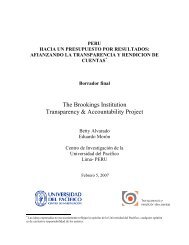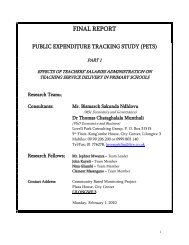Provider Purchasing and Contracting for Health Services_The Case
Provider Purchasing and Contracting for Health Services_The Case
Provider Purchasing and Contracting for Health Services_The Case
Create successful ePaper yourself
Turn your PDF publications into a flip-book with our unique Google optimized e-Paper software.
<strong>Contracting</strong> <strong>for</strong> nonclinical services<br />
Apart from clinical services, contracting mechanisms also apply to nonclinical services.<br />
Nonclinical services include security, catering, laundry, cleaning, maintenance, <strong>and</strong> printing.<br />
Although most public health facilities do not contract out the above services, a few of them<br />
do. <strong>The</strong> limited contracting in these services can be explained by the fact that most public<br />
institutions have departments tasked to per<strong>for</strong>m these duties. For instance, most of the public<br />
facilities have laundry, catering, cleaning, <strong>and</strong> printing facilities as well as personnel to carry<br />
out these services. For the most part, these employees are contracted on a short-term basis<br />
<strong>and</strong> are referred to as Classified Daily Employees (CDEs). Hospitals also hire personnel with<br />
specialized skills to supply the above services. This scenario also characterizes the faithbased<br />
organizations. Nonetheless, the government contracts with the private sector <strong>for</strong><br />
construction of infrastructure. Such contracts are h<strong>and</strong>led through the Zambia National<br />
Tender Board.<br />
On the other h<strong>and</strong>, contracting <strong>for</strong> nonclinical services is common in private <strong>for</strong>-profit<br />
facilities. Generally, the private <strong>for</strong>-profit providers noted that it is imperative to subcontract<br />
nonclinical services such as laundry <strong>and</strong> catering to enable them concentrate on providing<br />
their core services—health care provision. <strong>The</strong>re is very little evidence of serious negotiation<br />
between the contractors <strong>and</strong> contractees of these services. Usually, flat market rates apply,<br />
but discounts are also considered depending on the nature of the contract. Contract renewal is<br />
dependent on the quality of services provided. Contracts are subject to termination if one<br />
party is dissatisfied with the service.<br />
Over 90 percent of surveyed institutions that contract <strong>for</strong> nonclinical services observed that<br />
the quality <strong>and</strong> timely delivery of the services is the indicator of per<strong>for</strong>mance <strong>and</strong> the basis<br />
<strong>for</strong> renewal.<br />
7. Findings from <strong>Case</strong> Studies<br />
This section provides empirical characterizations of contracting models in Zambia based on<br />
the field work undertaken. <strong>The</strong> case studies covered six districts that were selected to depict<br />
the rural-urban dichotomy of the country. <strong>The</strong> study surveyed six District <strong>Health</strong><br />
Management Teams—the Choma, Mazabuka, Lusaka, Ndola, Kitwe Mufulira, <strong>and</strong> Chingola<br />
DHMTs—in order to characterize contracting in Zambia at the service delivery level. While<br />
the private <strong>for</strong>-profit sector is limited in Choma <strong>and</strong> Mazabuka, the other districts have a<br />
relatively large presence of private <strong>for</strong>-profit health care providers. Mazabuka <strong>and</strong> Choma<br />
have first-level mission hospitals. It was envisaged that the characteristics <strong>and</strong> perceptions of<br />
the changes in contracting arrangements in the sampled districts <strong>and</strong> hospitals would provide<br />
a proximate view of the situation in Zambia.<br />
<strong>Contracting</strong> <strong>and</strong> budgetary process<br />
Since the dissolution of the Central Board of <strong>Health</strong>, the Ministry of <strong>Health</strong> acts through the<br />
Provincial <strong>Health</strong> Offices as the principal in the contractual arrangements between the fundholding<br />
agents <strong>and</strong> the sources of the funds. <strong>The</strong> Ministry of <strong>Health</strong> has always acted as a<br />
source of funding. During its existence, the Central Board of <strong>Health</strong> operated as a financial<br />
46
















